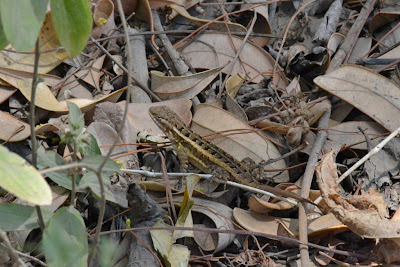 |
| The Central American Banded Gecko is very attractive, but its intricate pattern hides it well among leaf litter during the dry season. Photo by Laura Ruysseveldt. |
The tropical dry forest habitat of Laguna de Apoyo Nature Reserve dictates the kinds of animals found here. Both plants and animals must tolerate long months without rain, and in many areas, steeply inclined soils stripped of nutrients.
Several species of lizards adapt well to the habitats found here, as
conservation science interns Bryan Minne and Laura Ruysseveldt from Ghent University in Belgium found during their studies here.
 |
| The Central American Banded Gecko, Coleonyx mitratus, is uncommon in Laguna de Apoyo Nature Reserve. Photo by Laura Ruysseveldt. |
Bryan and Laura spent a few months in Nicaragua, studying the geckos and other reptiles and amphibians of Laguna de Apoyo Nature Reserve. They turned up some solid information on gecko habitats, particularly regarding the recently introduced Asian house gecko,
Hemidactylus frenatus, and its impact on native gecko species.
 |
| Field research on lizards and other herps usually includes a difficult process of identification. Photo by Laura Ruysseveldt. |
|
 |
| Asian house geckos (Hemidactylus frenatus) doing what they do best, which is among the reasons why they are now so abundant in Nicaragua, only a few decades after the first individuals arrived. Photo by Laura Ruysseveldt. |
 |
| Bryan and Jeffrey review trees for study plots for gecko habitats in Laguna de Apoyo Nature Reserve, Nicaragua. Photo by Laura Ruysseveldt. |
Field work included systematic reviews of habitats for geckos to determine how native species, particularly the Yellow-headed Gecko (
Gonatodes albogularis) and the Yellow-bellied Gecko (
Phyllodactylus tuberculosus) are responding to the invasion of the
Asian House Gecko (
Hemidactylus frenatus). Their project yielded some rigorous results, and they sweated a lot on long walks, but we are sure they are happy they came!
 |
| The Black-bellied Racerunner, Cnemidophorus deppei, is elusive and difficult to photograph in the wild. Photo by Laura Ruysseveldt. |
 |
| The Black Iguana, Ctenosaura similis, is an effective symbol for forest destruction in Nicaragua, as poachers often set forest fires to hunt them during the dry season. Photo by Laura Ruysseveldt. |
We often ask ourselves how can we assure the protection of lizards and other wildlife in Nicaragua. By sponsoring conservation science internships for students such as Laura and Bryan, we are learning more about our herpetofauna, including what problems each species may be facing. For instance, while surveying the reptiles in our area, the staff at
Estacion Biologica, along with Laura and Bryan, witnessed an attempt to capture a large Black Iguana (
Ctenosaura similis). We stopped the hunters as they chased the animal through a ravine, and then reported the activity of these people to the park rangers, who responded within minutes to warn the people that hunting is illegal inside the Laguna de Apoyo Nature Reserve.
 |
| The Rose-bellied Lizard, Sceloporus variabilis, is a close relative to several fence lizards found in the US and Mesoamerica, and is abundant in rocky and dry areas. Photo by Laura Ruysseveldt. |
Forest fires are often set to hunt iguanas and mammals. The fires destroy the habitat of and kill many smaller reptiles and other mammals, too. Laura and Bryan participated in extinguishing a forest fire that burned several hectares, just behind Estacion Biologica. Many animals live precariously in the forests where humans may abuse them in numerous ways.
 |
| Bryan examines a captured specimen before making a presentation on the reptiles of our area to the students of a local school. Photo by Laura Ruysseveldt. |
Bryan and Laura returned to their studies in Belgium after completing a detailed, quantitative project as well as lots of time in the jungle, in search of lizards and other reptiles, and hopefully, we can utilize their knowledge to promote better stewardship of wild nature in Nicaragua.










No comments:
Post a Comment